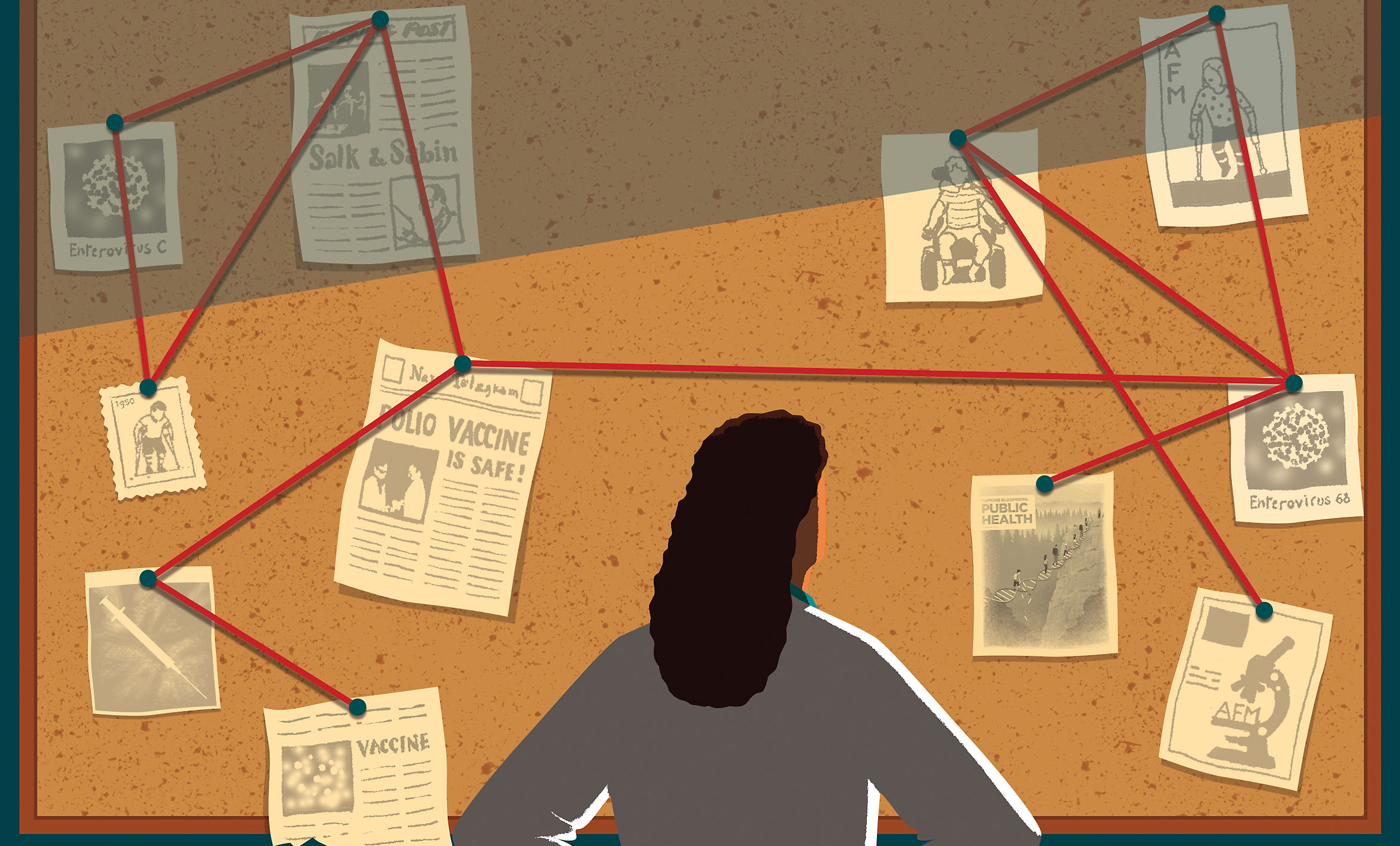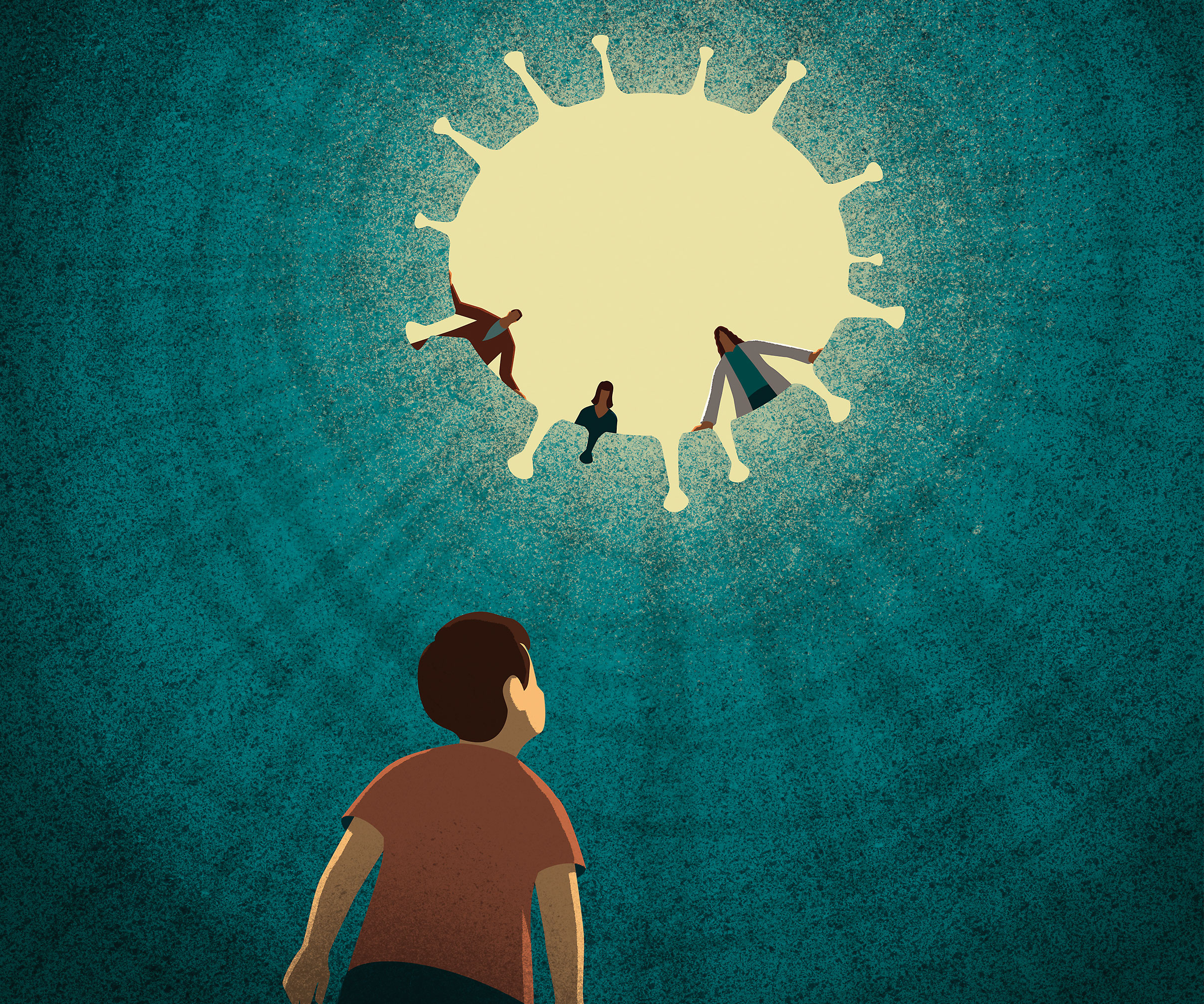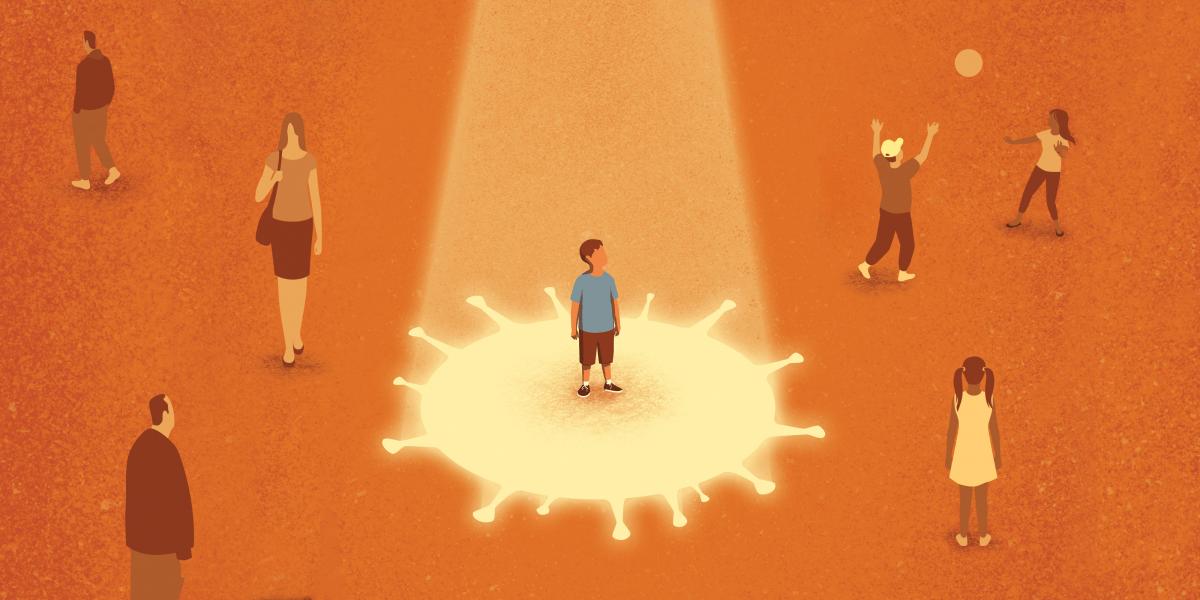AFM's Terrifying Randomness May Not Be So Random
Why does a virus leave one child paralyzed and others unscathed? Priya Duggal looks for clues in the human genome.
Nothing could dampen Rachel Scott’s spirits as she headed into the Fourth of July holiday in 2016—not the oppressive coastal Texas heat, nor the summer cold that had left the entire family with sore throats and sniffles. Friends had flown in from Kansas City for a weekend of cookouts and swimming, and Scott’s 5-year-old son, Braden, always looked forward to fireworks. So when Braden grew somewhat weak and listless, opting for a nap on the couch instead of a trip to the pool, Scott chalked it up to the cold. No one was quite feeling 100%.
But as the rest of the family began feeling better the next day, Braden got worse. He lost his ability to swallow and move his arm. Doctors puzzled over him for several days at the local children’s hospital as the paralysis claimed one part of his body after another. Then the paralysis hit his diaphragm. Braden stopped breathing. After being intubated and rushed to a major children’s hospital several hours away, Braden finally had a diagnosis: acute flaccid myelitis, a rapid-onset paralysis that leaves individuals weak and limp. The AFM diagnosis, however, didn’t provide Scott with any answers about what would happen to her son.
“There’s no treatment, no way to prevent it, and no solution for ongoing care,” Scott says.
Two thousand miles away, in her sixth-floor office at the Bloomberg School, epidemiologist Priya Duggal wanted to know why children like Braden got so sick. When the reports of AFM surged in fall 2014, Duggal, PhD ’03, MPH ’98, had turned to scientific literature for clues about why some children wound up paralyzed and found scientists asking the same frantic questions during the polio outbreaks of the 1940s and ’50s. Children, typically between ages 6 and 7, would wake up healthy and be unable to move or breathe on their own by the time they went to bed. Polio epidemics peaked each year in the late summer and early fall, the same as AFM.
Researchers had tentatively linked AFM with a virus called enterovirus D68. Enteroviruses are a large family of viruses that cause illnesses ranging from the common cold to polio. Huge spikes in D68 infections coincided with AFM, supporting the viral link.
But what didn’t make sense about the children with AFM is that there wasn’t an obvious chain of virus transmission. The children didn’t know each other, they didn’t all go to the same school and they weren’t even from the same communities. Epidemiologists had detected thousands of D68 cases, but only several hundred of AFM. Why, Duggal wondered, were kids like Braden paralyzed when so many other children barely even got a fever?
Many epidemiologists ask who gets sick and why, and they frequently look for answers in the environment and in the pathogen. Duggal, however, believes that some answers may lie in the human genome itself.
Of Germs and Genes
As soon as the first single-celled organisms appeared in the depths of ancient oceans, parasites and pathogens emerged to take advantage of their brethren. Over billions of years of evolution, this arms race between a pathogen’s need to infect a host and the host’s need to resist this infection has proved one of the most powerful forces shaping life on Earth. And human hosts are no exception. Approximately 10% of the human genome is devoted to the immune system, more than to any other organ system in the body. Analyses of the human genome from the last two years show that infectious disease continues to be one of the strongest shapers of our DNA.
Take malaria. A single mutation in the hemoglobin gene transforms Frisbee-shaped red blood cells into C-shaped sickles. Sickle cell mutations arose almost exclusively in the world’s malaria belt, as individuals who inherit mutant copies of this gene are less likely to get malaria. The same may be true for cystic fibrosis: Scientists have speculated that carriers of genes for cystic fibrosis, another inherited condition, may be more resistant to tuberculosis than noncarriers.

Epidemiologists have historically not focused on these links between human genetics and infectious disease. For one thing, finding these links would require sequencing genes from hundreds or thousands of people, a prohibitively expensive and time-consuming proposition. In addition, epidemiology had traditionally focused on connections between modifiable behaviors and environmental conditions rather than the more intractable genome.
“With an infectious disease, a lot of people just say, ‘Well, it was your behavior. It was your risk, or you were unfortunate enough to be exposed,’” says Duggal. “And we’re sort of saying, ‘Maybe there’s more to this story.’”
For Duggal, that story began when she was an MPH student at the Bloomberg School. In one of her first courses, she heard about a group of people who, despite engaging in a whole set of risky behaviors, seemed immune to HIV. When scientists looked more closely at the DNA of those resistant to HIV, they found that these individuals were missing a small section of the gene that made the protein HIV uses to enter cells. This deletion meant that HIV couldn’t enter T cells and start an infection. To Duggal, this discovery was mind-blowing. Scientists had figured out that a subset of people—approximately one in 10 northern Europeans—wouldn’t ever get HIV because of their genetics, other risk factors be damned.
Duggal stayed on at the School for her PhD in epidemiology, working with David Vlahov, PhD ’88, a professor in Epidemiology and at the Johns Hopkins School of Medicine who at the time ran the ALIVE (AIDS Linked to IntraVenous Experience) study. Ongoing since 1988, the ALIVE study has followed 2,938 Baltimore-area people who inject drugs, 700 of whom were HIV-positive at the start of the study. Vlahov and colleagues studied the progression of HIV and hepatitis C; Duggal worked with them to identify the potential contributions of host genetics. She continued her work on host genetics with the ALIVE study when she joined the Bloomberg School faculty in 2008, but switched her focus to hepatitis C.
This was a time when the cost to sequence a complete human genome began to plummet. In 2006, sequencing a human genome cost about $14 million; in 2017, it cost just $1,000. Sequencing a small subset of genes on an array cost only $50.
“A lot of us who work in the fields of genetic epidemiology or statistical genetics can argue that for not much more than a laboratory test, we can have your full genetics. For less than the cost of an MRI, I can tell you everything about you, whether or not I understand it. That’s pretty incredible,” Duggal says.
As genotyping and sequencing became more affordable, Duggal homed in on some of the genetic links to spontaneous HCV clearance, a feat managed by only one-quarter of those infected. Duggal and David Thomas, MD, MPH, a professor in Epidemiology and at the Johns Hopkins School of Medicine, found that participants carrying either of two mutations in the gene that codes for interferon lambda, an immune system protein produced in response to a viral infection, made them twice as likely to clear an HCV infection without treatment; having both variants gave them seven times the chance. A subsequent December 2018 study in Gastroenterology identified a third gene that could increase the odds of HCV remission. People of African and European ancestry carrying all of these variants were 24 times and 11 times, respectively, more likely to clear HCV.
If Duggal can understand why these genetic differences can lead to HCV clearance, scientists may be able to harness them to develop a vaccine to prevent the infection, she says.
Along with her work on HCV, Duggal also began to tease apart human genetic links to other infections, including parasitic diseases caused by Entamoeba histolytica, Cryptosporidium and Giardia, as well as viral diseases such as HIV and rotavirus. As Duggal was diving ever-deeper into the complex genetics of the human immune system, a strange new illness began to appear in the fall of 2014. AFM had begun to pop up, and Duggal found herself faced with a more challenging mystery than ever before.
Off the Sidelines
As she did most Wednesday evenings in the fall, Duggal watched her 6-year-old son chase a soccer ball up and down the field, his red shirt and black shorts illuminated by the glow of the fading sun. Accompanying her in the scrum of parents lining the field was fellow Hopkins epidemiologist and infectious disease physician Aaron Milstone, MD, MHS ’09, whose son was a year older than Duggal’s son. Whether in the pickup line at school or on the soccer field, Duggal and Milstone avoided talking about work. That evening, however, Duggal’s gregarious nature and contagious smile faded into worry.
“Have you heard about those sick kids?” she blurted out.
We are on the brink of polio eradication, and if we had a better understanding of polio, we would be better poised to handle AFM. If we don't answer these questions for AFM, we could have something else emerge right behind it.
Milstone had. Knowing they had no time to lose, Duggal and Milstone planned a collaborative project right there on the sidelines of that Baltimore soccer field. Their alarm was well-founded. Between August and December 2014, the CDC confirmed 120 cases of AFM across 33 states. Milstone, an infectious disease pediatrician at Johns Hopkins Hospital, would handle the clinical end through his contacts with a large collaborative network of pediatricians. Duggal would compare the DNA of children with AFM to that of their healthy siblings to try to identify any small segments of the genome that might explain why some children were paralyzed when others didn’t even know they had been infected.
He and Duggal reached out to a large physician network to find patients, but in early 2015, AFM and D68 cases dropped off and failed to return in the fall. Just as physicians started to exhale, the virus and associated paralysis returned in the fall of 2016. Two years later, in the fall of 2018, epidemiologists saw a similar pattern, with several hundred confirmed cases of AFM across the U.S. to date. Duggal’s mystery had become a major public health crisis.
CDC’s recognition of the crisis allowed Duggal and Milstone’s study to get off the ground. To formally enroll patients in the genetic study, Duggal spoke with nearly every parent and almost every single family member in more than 100 affected families around the country. Many recalled that everyone in the household was sick at the time, often with a mild flu-like illness, but only one child ended up paralyzed. The most common age for AFM to strike was between 6 and 7—the ages of Milstone’s and Duggal’s children.
“So many times a parent said to me, ‘One day my kid was playing soccer, the next he couldn’t move.’ Those stories get to you,” Duggal says. “When you talk to these families, you can sense the helplessness that we all feel. It’s not just the parents—it’s all of us. It’s personal for all of us,” Duggal says.
What was obvious, even from the first few cases that Duggal and Milstone reviewed, was the condition’s heterogeneity and severity. Some children had an affected arm, others an affected leg. Others had respiratory and facial changes. Paralysis affected either the right or left side of the body, but not both. And many children did not recover, even months or years after the paralysis began. (The CDC hasn’t been tracking AFM cases, which makes it hard to know how many children improved.) To Scott, whose son Braden has regained the ability to walk but remains reliant on a feeding tube and ventilator, Duggal’s ongoing interest has been invaluable.
“Priya is one of the only people investigating this. I’m just grateful that someone was interested in our kids. It was like a miracle,” Scott says.
Getting researchers to pay attention to AFM has been challenging, Scott says, but Duggal always took the time to answer her questions and explain the science. Her whole family provided genetic samples to Duggal’s study to help find answers for Braden.
Duggal has also helped lead the charge to increase awareness of AFM, including becoming a scientific adviser to the Acute Flaccid Myelitis Working Group and advocating for more research and support for parents.
“She has gone above and beyond what anyone would ever have expected of a researcher,” Scott says.
Echoes of an Epidemic
Even as Duggal and Milstone seek additional funding to help them continue their research, they realize that their work on AFM might help provide clues to polio—and vice versa. To this day, Duggal says, researchers don’t know why some children ended up in an iron lung while others never had a symptom.
“When you look back in the literature, we don’t have answers on that. It’s just sort of very accepted that a small group of people are going to end up paralyzed or dead or on a respirator for the rest of their lives,” Duggal says.

Although AFM is very clearly not caused by the polio virus, Duggal believes that the same underlying biological mechanisms could explain paralysis risk in both diseases. “We are on the brink of polio eradication, and if we had a better understanding of polio, we would be better poised to handle AFM,” she says. “And if we don’t answer these questions for AFM, we could have something else emerge right behind it.”
She began talking to adults who survived polio epidemics of the 1940s and ’50s, many of whom are now in their 80s, to try to understand these links. It’s an unorthodox approach, but Duggal believes that polio survivors may help provide vital clues to AFM and perhaps help scientists answer questions about paralytic viruses in general. Although Duggal’s research has no way of helping the survivors, she says they all generously donated their time and DNA because they know exactly what the AFM children are going through. They themselves lived it, so many decades before.
One of those polio survivors is John Nanni. The 66-year-old Delaware resident became paralyzed from the neck down from polio in 1953, when he was 10 months old. Intensive physical therapy by his mother restored movement to his limbs, and Nanni grew up giving little thought to the virus that almost killed him. Then, at age 40, the muscle weakness returned, accompanied by pain and extreme fatigue. Nanni’s subsequent diagnosis of post-polio syndrome catapulted him into advocacy work with the Rotary Club on the polio eradication campaign. When Nanni heard the first news reports of AFM, he says, “it scared the hell out of me.”
His work with the Rotary Club and several polio survivors’ associations meant he was one of the first to hear about Duggal’s work on polio survivors. Nanni immediately volunteered to participate. “Anything I can do to understand why some people are more susceptible to polio, I’ll do it,” he says.
In January 2019, Duggal submitted a grant to study the potential connections between AFM and polio more closely. She finished the paperwork just as the School’s Department of Epidemiology began the celebration of its centennial. The Department’s first chair, Wade Hampton Frost, faced many of the same questions about polio 100 years ago that Duggal is trying to answer about AFM today.
“When you see his descriptions and what health departments were describing, it’s as if it was 2014 and we were talking about AFM. It’s a classic example of when the more things change, the more they’re really the same. It’s just a new virus that’s likely causing the same type of disease,” Duggal says.
For Scott, these answers could mean a chance to help her son and understanding whether her other four children might be at risk. They could also offer the potential to prevent viral paralysis with new treatments or vaccines for AFM.
Duggal’s work may answer the field’s most fundamental and persistent questions of who gets sick and why—even for pathogens no one has studied. The AFM outbreaks, she says, are “a good example of why we’re here and what we do, which is that if a public health problem presents itself and you have skills to offer, now’s the time to start to step up.”
